语言学复习重点
- 格式:docx
- 大小:17.59 KB
- 文档页数:5
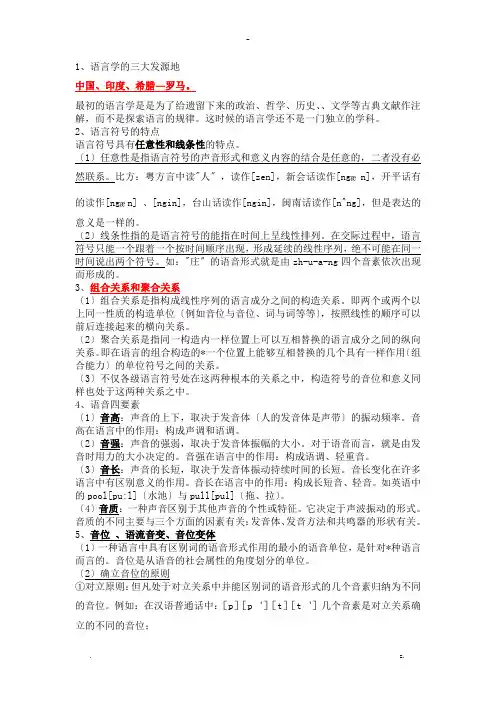
1、语言学的三大发源地中国、印度、希腊—罗马。
最初的语言学是是为了给遗留下来的政治、哲学、历史、、文学等古典文献作注解,而不是探索语言的规律。
这时候的语言学还不是一门独立的学科。
2、语言符号的特点语言符号具有任意性和线条性的特点。
〔1〕任意性是指语言符号的声音形式和意义内容的结合是任意的,二者没有必然联系。
比方:粤方言中读"人〞,读作[zen],新会话读作[ngæ n],开平话有的读作[ngæn] 、[ngin],台山话读作[ngin],闽南话读作[n^ng],但是表达的意义是一样的。
〔2〕线条性指的是语言符号的能指在时间上呈线性排列。
在交际过程中,语言符号只能一个跟着一个按时间顺序出现,形成延续的线性序列,绝不可能在同一时间说出两个符号。
如:"庄〞的语音形式就是由zh-u-a-ng四个音素依次出现而形成的。
3、组合关系和聚合关系〔1〕组合关系是指构成线性序列的语言成分之间的构造关系。
即两个或两个以上同一性质的构造单位〔例如音位与音位、词与词等等〕,按照线性的顺序可以前后连接起来的横向关系。
〔2〕聚合关系是指同一构造内一样位置上可以互相替换的语言成分之间的纵向关系。
即在语言的组合构造的*一个位置上能够互相替换的几个具有一样作用〔组合能力〕的单位符号之间的关系。
〔3〕不仅各级语言符号处在这两种根本的关系之中,构造符号的音位和意义同样也处于这两种关系之中。
4、语音四要素〔1〕音高:声音的上下,取决于发音体〔人的发音体是声带〕的振动频率。
音高在语言中的作用:构成声调和语调。
〔2〕音强:声音的强弱,取决于发音体振幅的大小。
对于语音而言,就是由发音时用力的大小决定的。
音强在语言中的作用:构成语调、轻重音。
〔3〕音长:声音的长短,取决于发音体振动持续时间的长短。
音长变化在许多语言中有区别意义的作用。
音长在语言中的作用:构成长短音、轻音。
如英语中的pool[pu:l]〔水池〕与pull[pul]〔拖、拉〕。
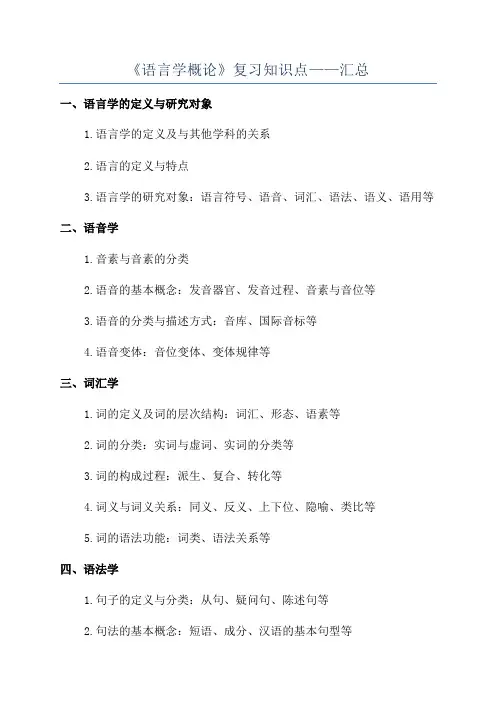
《语言学概论》复习知识点——汇总一、语言学的定义与研究对象1.语言学的定义及与其他学科的关系2.语言的定义与特点3.语言学的研究对象:语言符号、语音、词汇、语法、语义、语用等二、语音学1.音素与音素的分类2.语音的基本概念:发音器官、发音过程、音素与音位等3.语音的分类与描述方式:音库、国际音标等4.语音变体:音位变体、变体规律等三、词汇学1.词的定义及词的层次结构:词汇、形态、语素等2.词的分类:实词与虚词、实词的分类等3.词的构成过程:派生、复合、转化等4.词义与词义关系:同义、反义、上下位、隐喻、类比等5.词的语法功能:词类、语法关系等四、语法学1.句子的定义与分类:从句、疑问句、陈述句等2.句法的基本概念:短语、成分、汉语的基本句型等3.句法关系与句法结构:并列、从属、修饰等4.句法规则与句法分析:形式语法、语义角度的句法分析等5.语法现象的分析与解释:形式语法与功能语法的对比、语法规则、语法的普遍性、语法的可及性等五、语义学1.语义的定义与特点2.词义的构成与分类:词汇意义、语法意义、逻辑意义、上下文意义等3.语义关系与语义角色:同义、反义、上下位、隐喻、类比、关联等4.语义现象的分析与解释:语义成分的划分与关系、语义的可及性、语义的派生与转化等六、语用学1.语用学的定义与研究领域2.语言交际与语言交际行为:意图、目的、合作原则等3.言外之意与言外之行:言外之意的表示方式、言外之行的示例等4.语用现象的分析与解释:语言行为、语用规则、语用的多样性等七、语言学研究方法与分支学科1.语言学研究的方法论:描述性研究、实证研究等2.语言学的分支学科:应用语言学、对比语言学、历史语言学、社会语言学等3.参考书目和领域动态:《现代语言学导论》、《实用语义学》、《语法学》等这些都是《语言学概论》中的重要知识点,希望以上内容对您的复习有所帮助。
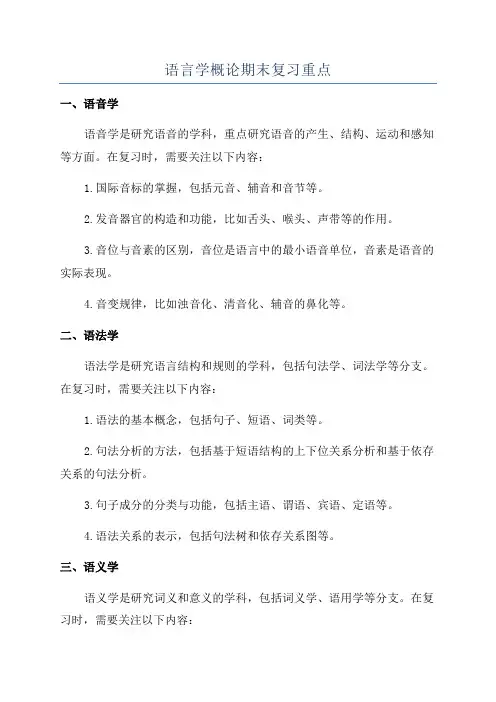
语言学概论期末复习重点一、语音学语音学是研究语音的学科,重点研究语音的产生、结构、运动和感知等方面。
在复习时,需要关注以下内容:1.国际音标的掌握,包括元音、辅音和音节等。
2.发音器官的构造和功能,比如舌头、喉头、声带等的作用。
3.音位与音素的区别,音位是语言中的最小语音单位,音素是语音的实际表现。
4.音变规律,比如浊音化、清音化、辅音的鼻化等。
二、语法学语法学是研究语言结构和规则的学科,包括句法学、词法学等分支。
在复习时,需要关注以下内容:1.语法的基本概念,包括句子、短语、词类等。
2.句法分析的方法,包括基于短语结构的上下位关系分析和基于依存关系的句法分析。
3.句子成分的分类与功能,包括主语、谓语、宾语、定语等。
4.语法关系的表示,包括句法树和依存关系图等。
三、语义学语义学是研究词义和意义的学科,包括词义学、语用学等分支。
在复习时,需要关注以下内容:1.语义的基本概念,包括词义、句义、语篇意义等。
2.词义的分类,包括编码词义和概念词义等。
3.语义关系的表示,包括隐性关系和显性关系等。
4.语义义原的掌握,比如用来描述词义的最小单位,可以用来解释多义、歧义、同义等现象。
四、语用学语用学是研究语言在特定情境中的使用和理解的学科,包括语用规则、言语行为等方面。
1.言语行为的分类,包括表示、指示、陈述、询问等。
2.言语行为的成分,包括言辞、语境、意图等。
3.语用规则的掌握,比如礼貌原则、言外之意等。
4.言语行为的实现方式,包括直接言语行为和间接言语行为等。
以上仅为语言学概论期末复习的一些重点内容,学生可以结合教材和课堂笔记进行更深入的学习和理解。
此外,复习时可以参考相关的案例和实例,加深对语言学原理的理解和应用。
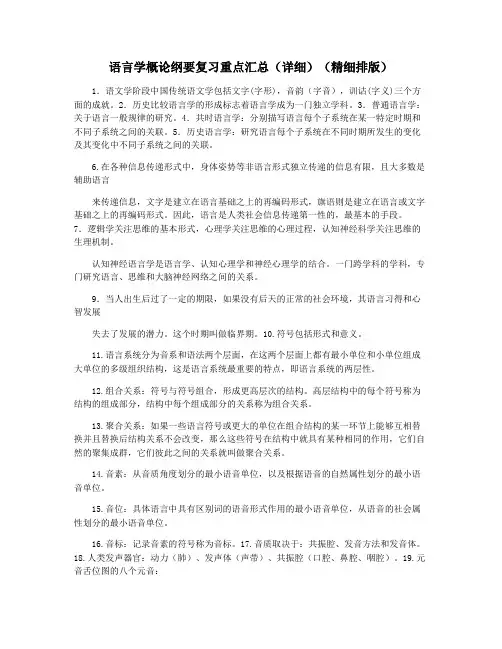
语言学概论纲要复习重点汇总(详细)(精细排版)1.语文学阶段中国传统语文学包括文字(字形),音韵(字音),训诂(字义)三个方面的成就。
2.历史比较语言学的形成标志着语言学成为一门独立学科。
3.普通语言学:关于语言一般规律的研究。
4.共时语言学:分别描写语言每个子系统在某一特定时期和不同子系统之间的关联。
5.历史语言学:研究语言每个子系统在不同时期所发生的变化及其变化中不同子系统之间的关联。
6.在各种信息传递形式中,身体姿势等非语言形式独立传递的信息有限,且大多数是辅助语言来传递信息,文字是建立在语言基础之上的再编码形式,旗语则是建立在语言或文字基础之上的再编码形式。
因此,语言是人类社会信息传递第一性的,最基本的手段。
7.逻辑学关注思维的基本形式,心理学关注思维的心理过程,认知神经科学关注思维的生理机制。
认知神经语言学是语言学、认知心理学和神经心理学的结合。
一门跨学科的学科,专门研究语言、思维和大脑神经网络之间的关系。
9.当人出生后过了一定的期限,如果没有后天的正常的社会环境,其语言习得和心智发展失去了发展的潜力。
这个时期叫做临界期。
10.符号包括形式和意义。
11.语言系统分为音系和语法两个层面,在这两个层面上都有最小单位和小单位组成大单位的多级组织结构,这是语言系统最重要的特点,即语言系统的两层性。
12.组合关系:符号与符号组合,形成更高层次的结构。
高层结构中的每个符号称为结构的组成部分,结构中每个组成部分的关系称为组合关系。
13.聚合关系:如果一些语言符号或更大的单位在组合结构的某一环节上能够互相替换并且替换后结构关系不会改变,那么这些符号在结构中就具有某种相同的作用,它们自然的聚集成群,它们彼此之间的关系就叫做聚合关系。
14.音素:从音质角度划分的最小语音单位,以及根据语音的自然属性划分的最小语音单位。
15.音位:具体语言中具有区别词的语音形式作用的最小语音单位,从语音的社会属性划分的最小语音单位。
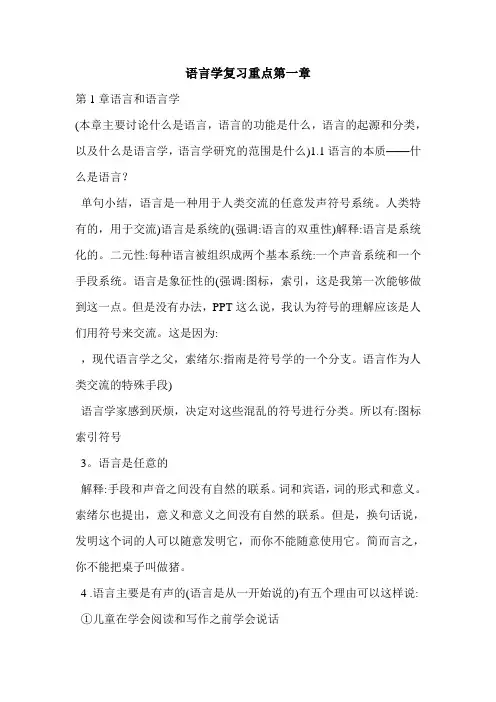
语言学复习重点第一章第1章语言和语言学(本章主要讨论什么是语言,语言的功能是什么,语言的起源和分类,以及什么是语言学,语言学研究的范围是什么)1.1语言的本质——什么是语言?单句小结,语言是一种用于人类交流的任意发声符号系统。
人类特有的,用于交流)语言是系统的(强调:语言的双重性)解释:语言是系统化的。
二元性:每种语言被组织成两个基本系统:一个声音系统和一个手段系统。
语言是象征性的(强调:图标,索引,这是我第一次能够做到这一点。
但是没有办法,PPT这么说,我认为符号的理解应该是人们用符号来交流。
这是因为:,现代语言学之父,索绪尔:指南是符号学的一个分支。
语言作为人类交流的特殊手段)语言学家感到厌烦,决定对这些混乱的符号进行分类。
所以有:图标索引符号3。
语言是任意的解释:手段和声音之间没有自然的联系。
词和宾语,词的形式和意义。
索绪尔也提出,意义和意义之间没有自然的联系。
但是,换句话说,发明这个词的人可以随意发明它,而你不能随意使用它。
简而言之,你不能把桌子叫做猪。
4 .语言主要是有声的(语言是从一开始说的)有五个理由可以这样说:①儿童在学会阅读和写作之前学会说话(2)儿童在成长过程中自己学习语言(3)在人类历史上,有先说后写(4)写作是以语言为基础的(5)人们说得多写得少(5)。
语言是人类特有的(语言是人类独有的)解释:因为,人类语言具有以下特征:(1)置换199 (2)生产力或创造力:人类有能力生产和理解。
③文化传播:学习作为人类语言的一个因素比动物交流更重要。
4结构复杂性语言的结构复杂无界动物交流系统是封闭的。
当他还是个孩子的时候,他不知道该做什么。
语言不仅是一种心理现象,也是一种社会事实。
语言功能分为两类,一类是通用功能,一类是元功能,元功能(注:通用功能是专用的,特殊应用;元函数涵盖更广泛的更抽象的函数) 1。
一般功能:指个人对语言的具体使用英寸列出了7种一般功能:①生理/表达/情绪功能心理学\ \表达\ \情绪功能:这种功能没有交际目的。
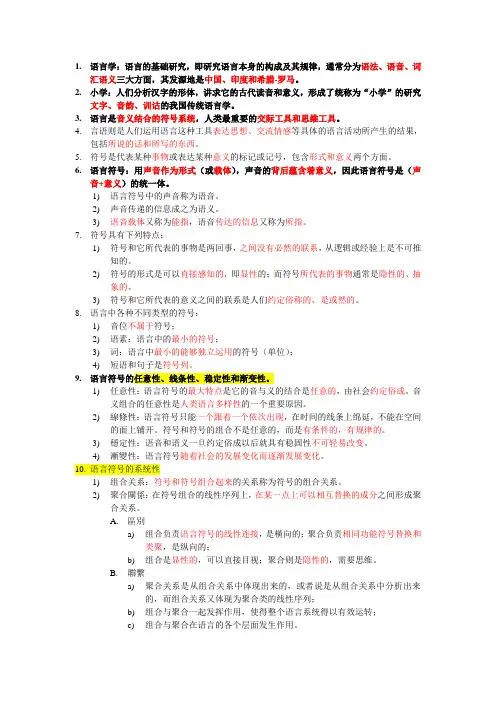
1.语言学:语言的基础研究,即研究语言本身的构成及其规律,通常分为语法、语音、词汇语义三大方面,其发源地是中国、印度和希腊-罗马。
2.小学:人们分析汉字的形体,讲求它的古代读音和意义,形成了统称为“小学”的研究文字、音韵、训诂的我国传统语言学。
3.语言是音义结合的符号系统,人类最重要的交际工具和思维工具。
4.言语则是人们运用语言这种工具表达思想、交流情感等具体的语言活动所产生的结果,包括所说的话和所写的东西。
5.符号是代表某种事物或表达某种意义的标记或记号,包含形式和意义两个方面。
6.语言符号:用声音作为形式(或载体),声音的背后蕴含着意义,因此语言符号是(声音+意义)的统一体。
1)语言符号中的声音称为语音。
2)声音传递的信息成之为语义。
3)语音载体又称为能指,语音传达的信息又称为所指。
7.符号具有下列特点:1)符号和它所代表的事物是两回事,之间没有必然的联系,从逻辑或经验上是不可推知的。
2)符号的形式是可以直接感知的,即显性的;而符号所代表的事物通常是隐性的、抽象的。
3)符号和它所代表的意义之间的联系是人们约定俗称的,是或然的。
8.语言中各种不同类型的符号:1)音位不属于符号;2)语素:语言中的最小的符号;3)词:语言中最小的能够独立运用的符号(单位);4)短语和句子是符号列。
9.语言符号的任意性、线条性、稳定性和渐变性。
1)任意性:语言符号的最大特点是它的音与义的结合是任意的,由社会约定俗成。
音义组合的任意性是人类语言多样性的一个重要原因。
2)線條性:语言符号只能一个跟着一个依次出现,在时间的线条上绵延,不能在空间的面上铺开。
符号和符号的组合不是任意的,而是有条件的,有规律的。
3)穩定性:语音和语义一旦约定俗成以后就具有稳固性不可轻易改变。
4)漸變性:语言符号随着社会的发展变化而逐渐发展变化。
10.语言符号的系统性1)组合关系:符号和符号组合起来的关系称为符号的组合关系。
2)聚合關係:在符号组合的线性序列上,在某一点上可以相互替换的成分之间形成聚合关系。
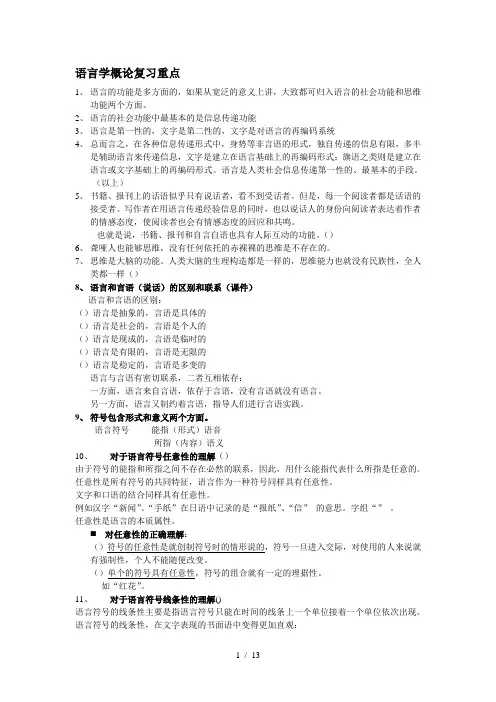
语言学概论复习重点1、语言的功能是多方面的,如果从宽泛的意义上讲,大致都可归入语言的社会功能和思维功能两个方面。
2、语言的社会功能中最基本的是信息传递功能3、语言是第一性的,文字是第二性的,文字是对语言的再编码系统4、总而言之,在各种信息传递形式中,身势等非言语的形式,独自传递的信息有限,多半是辅助语言来传递信息,文字是建立在语言基础上的再编码形式;旗语之类则是建立在语言或文字基础上的再编码形式。
语言是人类社会信息传递第一性的、最基本的手段。
(以上)5、书籍、报刊上的话语似乎只有说话者,看不到受话者。
但是,每一个阅读者都是话语的接受者。
写作者在用语言传递经验信息的同时,也以说话人的身份向阅读者表达着作者的情感态度,使阅读者也会有情感态度的回应和共鸣。
也就是说,书籍、报刊和自言自语也具有人际互动的功能。
()6、聋哑人也能够思维,没有任何依托的赤裸裸的思维是不存在的。
7、思维是大脑的功能。
人类大脑的生理构造都是一样的,思维能力也就没有民族性,全人类都一样()8、语言和言语(说话)的区别和联系(课件)语言和言语的区别:()语言是抽象的,言语是具体的()语言是社会的,言语是个人的()语言是现成的,言语是临时的()语言是有限的,言语是无限的()语言是稳定的,言语是多变的语言与言语有密切联系,二者互相依存:一方面,语言来自言语,依存于言语,没有言语就没有语言。
另一方面,语言又制约着言语,指导人们进行言语实践。
9、符号包含形式和意义两个方面。
语言符号能指(形式)语音所指(内容)语义10、对于语言符号任意性的理解()由于符号的能指和所指之间不存在必然的联系,因此,用什么能指代表什么所指是任意的。
任意性是所有符号的共同特征,语言作为一种符号同样具有任意性。
文字和口语的结合同样具有任意性。
例如汉字“新闻”、“手纸”在日语中记录的是“报纸”、“信”的意思。
字组“”。
任意性是语言的本质属性。
对任意性的正确理解:()符号的任意性是就创制符号时的情形说的,符号一旦进入交际,对使用的人来说就有强制性,个人不能随便改变。
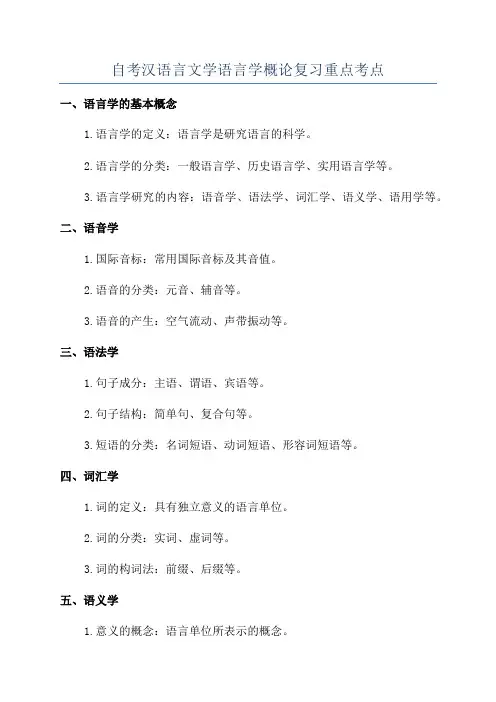
自考汉语言文学语言学概论复习重点考点
一、语言学的基本概念
1.语言学的定义:语言学是研究语言的科学。
2.语言学的分类:一般语言学、历史语言学、实用语言学等。
3.语言学研究的内容:语音学、语法学、词汇学、语义学、语用学等。
二、语音学
1.国际音标:常用国际音标及其音值。
2.语音的分类:元音、辅音等。
3.语音的产生:空气流动、声带振动等。
三、语法学
1.句子成分:主语、谓语、宾语等。
2.句子结构:简单句、复合句等。
3.短语的分类:名词短语、动词短语、形容词短语等。
四、词汇学
1.词的定义:具有独立意义的语言单位。
2.词的分类:实词、虚词等。
3.词的构词法:前缀、后缀等。
五、语义学
1.意义的概念:语言单位所表示的概念。
2.意义的分类:词义、句义、上下文义等。
3.意义的变化:词义的扩大和缩小等。
六、语用学
1.语用学的概念:研究语言实际使用情况的学科。
2.语用学的要素:语言行为、语用规则等。
3.语用失误:歧义、言外之意等。
七、其他
1.汉语言文字的演变:甲骨文、小篆、楷书等。
2.语言与社会文化的关系:语言的社会属性、语言的地位等。
3.语言变异现象:方言、行话、新词等。
以上是自考汉语言文学语言学概论的复习重点和考点,希望能对您的复习有所帮助。
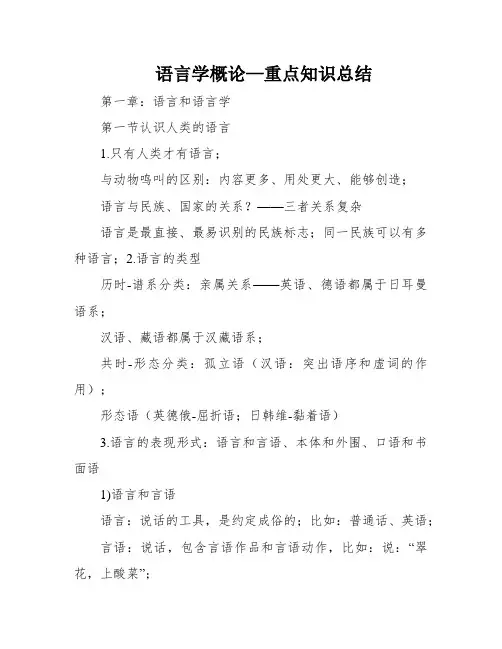
语言学概论—重点知识总结第一章:语言和语言学第一节认识人类的语言1.只有人类才有语言;与动物鸣叫的区别:内容更多、用处更大、能够创造;语言与民族、国家的关系?——三者关系复杂语言是最直接、最易识别的民族标志;同一民族可以有多种语言;2.语言的类型历时-谱系分类:亲属关系——英语、德语都属于日耳曼语系;汉语、藏语都属于汉藏语系;共时-形态分类:孤立语(汉语:突出语序和虚词的作用);形态语(英德俄-屈折语;日韩维-黏着语)3.语言的表现形式:语言和言语、本体和外围、口语和书面语1)语言和言语语言:说话的工具,是约定成俗的;比如:普通话、英语;言语:说话,包含言语作品和言语动作,比如:说:“翠花,上酸菜”;2)选择/名词:本体和外围本体:语言内部包含的要素,比如:语音、语法、语义;外围:语言和其他事物的关系,比如:语言和思维、语言和历史、语言和民族文化;3)口语和口语口语:说的话;第一性的,是书面语产生的基础书面语:写的字;第二性,在口语的基础上,加工提炼而成;第二节语言符号和语言结构1.语言符号必须同时具有表示具体意义的物质实体(红绿灯)和物质实体所表示的特定意义(红灯停绿灯行);2.语言的符号特性:能指和所指、约定和任意、不变和可变;1)能指和所指(口诀:能声所意)能指:把语言符号中能够指称某种意义的声音称为“能指”;所指:把语言符号中有特定声音表示的意义称为“所指”;2)约定和任意约定:人为的规定任意:符号表示意义没有必然联系,只需人人都认定或气就行3)不变和可变可变性的根本原因在于任意性3.语言的结构特性:线性和离散、组合和聚合、层次和层级1)线性和离散:构成语言结构的基础条件;线性:语言符号只能一个一个按工夫顺序成一条线排列;离散性:语言符合可以分解还原成一个一个的符号(词);2)组合和聚合组合:哪一个成分在前、哪一个成分在后的结构特征;(又叫句法功用)聚合:同一类成分可以相互替换的结构特性;3)层次和层级层次:一个小单位内部的成分组合叫做“层次”;(语素组合成词、词组合成词组、词组组合成句子)层级:各个小单位之间的联系叫做“层级”;(词和词一级的内在分别)第三节研究语言的科学1.学科研究的方向分类:本体研究、语言与心理、语言和使用;1)本体研究:对语音、语汇、语法、语义的研究;2)语言与心理研究:语言和心理之间的关系和相互影响;3)语言与应用研究:语言学和信息处理,把理论在实践中的运用;2.语言与哲学1)“名无固宜,约之以命,约定俗成谓之宜……”出自XXX的《正名篇》;2)“小学”包括:《文字学》、《音韵学》、《训诂学》;3.语言研究1)XXX的《通俗语言学教程》提出了“结构主义语言学”“能指和所指”,是结构语言学的奠基人;2)XXX:北美结构主义学家,间接成分分析法;3)乔姆斯基的“转换生成语法”,包括普遍语法、句法自治等观点;第二章语言的物质载体——语音第一节语音概说1.语音:“人说话的声音”,更严格地说,语音是人的发音器官发出的、用于人与人之间交际并表达一定意义的声音。
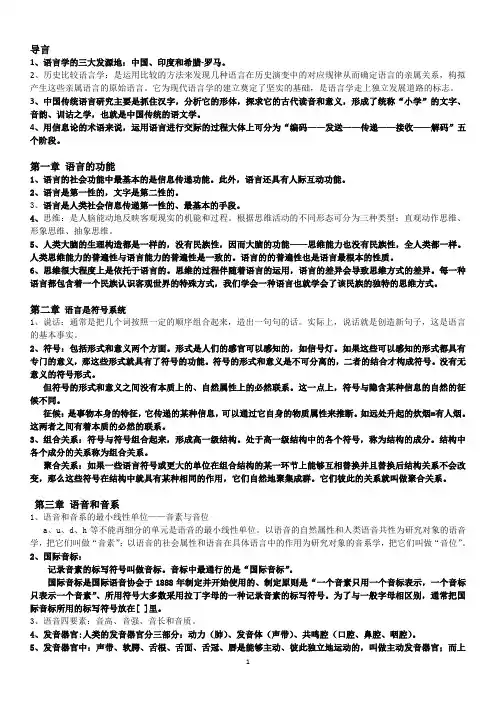
导言1、语言学的三大发源地:中国、印度和希腊-罗马。
2、历史比较语言学:是运用比较的方法来发现几种语言在历史演变中的对应规律从而确定语言的亲属关系,构拟产生这些亲属语言的原始语言。
它为现代语言学的建立奠定了坚实的基础,是语言学走上独立发展道路的标志。
3、中国传统语言研究主要是抓住汉字,分析它的形体,探求它的古代读音和意义,形成了统称“小学”的文字、音韵、训诂之学,也就是中国传统的语文学。
4、用信息论的术语来说,运用语言进行交际的过程大体上可分为“编码——发送——传递——接收——解码”五个阶段。
第一章语言的功能1、语言的社会功能中最基本的是信息传递功能。
此外,语言还具有人际互动功能。
2、语言是第一性的,文字是第二性的。
3、语言是人类社会信息传递第一性的、最基本的手段。
4、思维:是人脑能动地反映客观现实的机能和过程。
根据思维活动的不同形态可分为三种类型:直观动作思维、形象思维、抽象思维。
5、人类大脑的生理构造都是一样的,没有民族性,因而大脑的功能——思维能力也没有民族性,全人类都一样。
人类思维能力的普遍性与语言能力的普遍性是一致的。
语言的的普遍性也是语言最根本的性质。
6、思维很大程度上是依托于语言的。
思维的过程伴随着语言的运用,语言的差异会导致思维方式的差异。
每一种语言都包含着一个民族认识客观世界的特殊方式,我们学会一种语言也就学会了该民族的独特的思维方式。
第二章语言是符号系统1、说话:通常是把几个词按照一定的顺序组合起来,造出一句句的话。
实际上,说话就是创造新句子,这是语言的基本事实。
2、符号:包括形式和意义两个方面。
形式是人们的感官可以感知的,如信号灯。
如果这些可以感知的形式都具有专门的意义,那这些形式就具有了符号的功能。
符号的形式和意义是不可分离的,二者的结合才构成符号。
没有无意义的符号形式。
但符号的形式和意义之间没有本质上的、自然属性上的必然联系。
这一点上,符号与隐含某种信息的自然的征候不同。
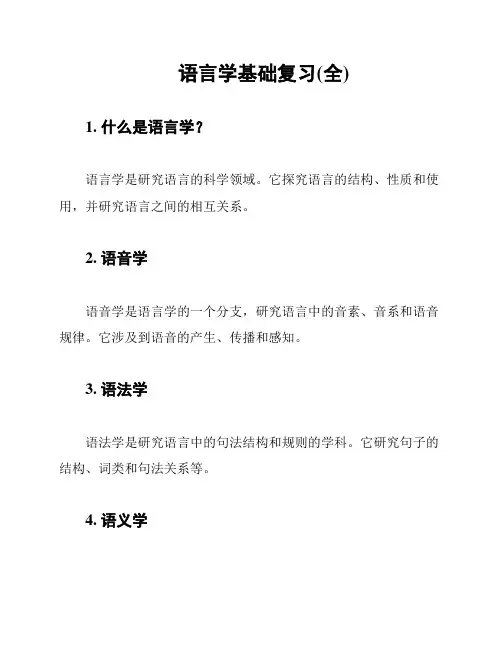
语言学基础复习(全)
1. 什么是语言学?
语言学是研究语言的科学领域。
它探究语言的结构、性质和使用,并研究语言之间的相互关系。
2. 语音学
语音学是语言学的一个分支,研究语言中的音素、音系和语音规律。
它涉及到语音的产生、传播和感知。
3. 语法学
语法学是研究语言中的句法结构和规则的学科。
它研究句子的结构、词类和句法关系等。
4. 语义学
语义学研究语言中词语、短语和句子的意义。
它关注词义、义项和语义关系等。
5. 语用学
语用学研究语言的使用方式和交际功能。
它研究语言的意图、推理和上下文等因素。
6. 语言变异和语言变化
语言变异和语言变化是研究语言不同方言、变体以及语言演变过程的学科。
7. 语言学与其他学科的关系
语言学与其他学科如心理学、认知科学、社会学和人机交互等有紧密的联系和应用。
8. 语言学的研究方法
语言学采用多种研究方法,包括实地调查、语料库研究、实验
研究和理论推导等。
9. 语言学的应用领域
语言学的应用领域包括教育、语言教学、翻译、语音识别、自
然语言处理等。
10. 语言学的发展前景
随着科技的进步和社会的发展,语言学在多个领域将继续发展,如自然语言处理、人机交互、机器翻译等。
以上是对语言学基础的简要复习,希望能够帮助你加深对语言
学的理解。
语言学概要复习提纲一、导言一、语言学的对象和任务(一)语言学的对象和任务1.定义:语言学是研究语言现象和规律的科学。
2.研究对象:语言。
语言学概论的研究对象:整个人类的语言。
3.主要任务:研究语言的性质、作用、结构和规律,使对语言的认识上升到理性阶段。
4.语言的基本理解语言的性质:是人类最重要的交际工具和思维工具。
语言的结构:是音义结合的符号系统。
语言的要素:语音、语义和词汇、语法。
(二)语言学简史(语文学与语言学)1.语文学阶段(1)三大发源地:①印度②希腊-罗马③中国(2)语文学的作用语文学三大发源地的语言研究各有侧重,共同特点是都注重实用性,与当时社会的需求紧密关联,都形成了丰硕的研究成果,为语言学的诞生奠定了坚实的基础。
(3)语文学与语言学的区别①研究对象不同②研究任务不同因此,语言学是一门独立的学科,语文学只是经学的附庸。
2.语言学阶段(1)历史比较语言学产生时间:19世纪初社会背景:资产阶级革命的成功特点:用历史比较法研究语言奠基人:拉斯克、葆朴、格林等。
历史地位:摆脱了过去从属经学的附庸地位,标志着语言学走上独立发展的道路。
(2)结构主义语言学基础:历史比较语言学时间:19世纪中叶奠基人:德国的洪堡特和瑞士的索绪尔索绪尔被尊称为“现代语言学之父”,他死后由其学生编辑出版的《普通语言学教程》具有划时代的作用。
索绪尔提出的主要理论是:①区分“语言”、“言语”和“言语活动”。
②明确了语言学的研究对象:“语言学的唯一的、真正的对象就是语言和为语言而研究语言。
③论证了语言的符号性:语言符号是由“能指”和“所指”所构成的。
④提出了组合关系和聚合关系。
(3)转换生成(形式)语言学创始人:乔姆斯基(《句法结构》)主要观点:认为语言描写和分析的目的不在于分类,而在于建立一种理论,在于研究人的语言生成能力,即怎样用有限的成分和规则生成无限的句子。
理论构成:主要包括生成规则和转换规则两部分。
①生成规则包括一套短语结构规则和词汇插入规则。
语言学概论复习重点一、名词解释1、音位音位是一定的语言或方言系统中,能区别不同语言符号的最小语音单位,是根据语音的社会性质划分出来的。
(斜线//是音位标记。
)音位是最小的语音形式,不能再切分。
音位虽能再分成若干区别性语音特征,但一个单一的语音特征不能构成一种语音形式。
2、非音质音位非音质音位是以音高、音长、音强为语音形式的音位,又叫超音质音位或超音段音位。
非音质音位包括调位、时位和重位三种。
3、国际音标国际音标是国际语音协会于1888年指定并开始使用的。
它的指定原则是“一个因素只用一个音标表示。
一个音标只表示一个因素”,因素和标写符号一一对应。
不会出现混淆或两可的现象。
为了与一般的字母相区别。
通常把国际音标所用的标写符号放在方括号[ ]里。
国际音标所代表的音是全世界一致的,我们不要把它和具体语言中形状相同的字母的读音混为一谈。
4、语流音变在连续的语流中,由于受邻近音的影响或由于说话时快慢、高低、强弱的不同所引起的语音变化叫做语流音变。
常见的语流音变现象主要有同化、异化、弱化、脱落四种。
5、语言的分化一种语言内部分成几种不同的方言,或者这些方言进而分成几种不同的语言,这种现象,叫做语言分化。
语言是随着社会的分化而分化的,也就是说,社会的分化是语言分化的原因。
主要表现为三种形式:社会方言、地域方言和亲属语言。
6、聚合关系聚合关系在语言学上聚合关系指在结构的某个特殊位置上可以相互替代的成分之间的关系或者是共现的成分和非共现的成分之间的关系,同一聚合关系语句只受句法关系限制语义因素不在考虑范围处于聚合关系中的语句与共同的句法特征但在语义上不能互相替换聚合关系就是语言结构某一位置上能够互相替换的具有某种相同作用的单位(如音位、词)之间的关系,简单说就是符号与符号之间的替换关系。
几个词,一组词,他们性质相同,具有同样的组合功能,在语言结构的同一个位置上可以互相替换,替换后生成不同的句子,这些词之间的这种替换关系,就是聚合关系。
语言学复习重点Chapter 1 绪论1. What is linguistics? 什么是语言学?Linguistics is generally defined as the scientific study of language. It studies not any particular language, but languages in general.2. The scope of linguistics 语言学的研究范畴The study of language as a whole is often called general linguistics. (普通语言学)The study of sounds, which are used in linguistic communication, is called phonetics. (语音学)The study of how sounds are put together and used in communication is called phonology. (音系学)The study of the way in which morphemes are arranged to form words are called morphology.(形态学)The study of how morphemes and words are combined to form sentences is called syntax. (句法学)The study of meaning in language is called semantics. (语义学)The study of meaning in context of use is called pragmatics. (语用学)The study of language with reference to society is called socio-linguistics. (社会语言学)The study of language with reference to the working of mind is called psycho-linguistics. (心理语言学)The study of applications (as the recovery of speech ability) is generally known as applied linguistics. (应用语言学)But in a narrow sense, applied linguistics refers to the application of linguistic principles and theories to language teaching andlearning, especially the teaching of foreign and second language.Other related branches include anthropological linguistics, (人类语言学)neurological linguistics, (神经语言学)mathematical linguistics, (数字语言学)and computational linguistics. (计算机语言学)3. Some important distinctions in linguistics语言学研究中的几对基本概念Prescriptive and descriptive 规定与描写If a linguistic study describes and analyzes the language people actually use, it is said to be descriptive, if it aims to lay down rules to tell people what they should say and what they should not say, it is said to be prescriptive.Modern linguistics differs from traditional grammar. Traditional grammar is prescriptive while modern linguistics is descriptive. The task of linguists is supposed to describe the language people actually use, whether it is “correct” or not. Synchronic and diachronic 共时和历时The description of a language at some point in time is a synchronic study; the description of a language as it changes through time is a diachronic study. In modern linguistics, synchronic study is more important.Speech and writing 口头语与书面语Speech and writing are the two major media of communication. Modern linguistics regards the spoken form of language as primary, but not the written form. Reasons are: 1. Speech precedes writing; 2. There are still many languages that have only the spoken form; 3. In terms of function, the spoken language is used for a wider range of purposes than the written, and carries a larger load of communication than the written.Langue and parole 语言和言语The Swiss linguist F. de Saussure made the distinction between langue and parole early 20th century.Langue refers to the abstract linguistic system shared by all the members of a speech community, and parole refers to the realization of langue in actual use. Saussure made the distinction in order to single out one aspect of language for serious study. He believes what linguists should do is to abstract langue from parole, to discover the regularities governing the actual use of language and make them the subjects of study of linguistics.Competence and performance 语言能力和语言运用Proposed by American linguist N. Chomsky in the late 1950?s.He defines competence as the ideal user?s knowledge of the rules of his language, and performance the actual realization of this knowledge in linguistic communication. He believes the task of the linguists is to discover and specify the language rules.4.What is language? 语言的定义Language is a system of arbitrary vocal symbols used for human communication.Sapir uses “ideas” “emotions” and “desires” in his definition. Hall, like Sapir, tr eats language as a purely human institution. Chomsky?s definition is quite different, it focus on the purely structural properties of languages and to suggest that these properties can be investigated from a mathematically precise point of view.5. Design features 语言的甄别性特征Design features refer to the defining properties of human language that distinguish it from any animal system of communication. American linguist Charles Hockett specified twelve design features, five of which will be discussed here.Arbitrariness 语言的随意性Arbitrariness means that there is no logical connection between meanings and sounds. It is not entirely arbitrary. Example: different sounds are used to refer to the same object in different languages.Productivity 语言的创造性Language is productive in that it makes possible the construction and interpretation of new signals by its users. This is why they can produce and understand an infinitely large number of sentences, including sentences they have never heard before.Duality 语言的二重性The duality nature of language means that language is a system, which consists of two sets of structure, or two levels, one of sounds and the other of meaning.Displacement 语言的移位性Displacement means that language can be used to refer to things which are present or not present, real or imagined matters in the past, present, or future, or in far-away places.Cultural transmission 语言的文化传递性While human capacity for language has a genetic basis, i.e., we were born with the ability to acquire language, the details of any language are not genetically transmitted, but instead have to be taught and learned anew. This indicates that language is culturally transmitted. It is passed down from one generation to the next through teaching and learning, rather than by instinct.Chapter 2 Phonology 音系学1. The phonic medium of language 语言的声音媒介Speech and writing are the two media used by natural languages as vehicles for communication. Of the two media of language, speech is more basic than writing. Speech is prior towriting. The writing system of any language is always “invented” by its users to record speech when the need arises.For linguists, the study of sounds is of greater importance than that of writing.The limited ranges of sounds which are meaningful in human communication and are of interest to linguistic studies are the phonic medium of language (语言的声音媒介) . The individual sounds within this range are the speech sounds (语音).2.What is phonetics?什么是语音学?Phonetics is defined as the study of the phonic medium of language;It is concerned with all the sounds that occur in the world?s languages.语音学研究的对象是语言的声音媒介,即人类语言中使用的全部语音。
语言学概论复习重点整理语言学是研究语言的科学,是人类学科中的重要分支之一。
它探讨语言的构成、发展、使用、习得等方面的问题。
在语言学的学习中,有几个重点需要重点关注和复习,包括语言的定义与特点、语音学、语法学、语义学、语用学等。
一、语言的定义与特点语言可以定义为人类交流思想和感情的工具,它具有符号性、产生性、传递性和交际性等特点。
符号性是指语言以音、形、色、势等形式来表达,具有特定的语音、文字等符号。
产生性是指语言是人类天生具备的能力,可以随意创造和组合新的语言表达。
传递性是指语言是为了交流而产生的,可以传递信息和意义。
交际性是指语言是社会交往的工具,是人类社会生活的基础。
二、语音学语音学研究语音的产生、组织、传播和知觉等问题。
语音由音段和音素组成,音段是语言中的基本音单位,而音素则是语音学上对音段的理论抽象。
语音学重点研究了语音的发音和声音的特征,包括元音、辅音、音节结构、音位等内容。
三、语法学语法学研究语言的结构和规则,包括句子的构成、词汇的分类和句子的句法规则等。
语法学可以分为句法学、词法学和语法规则等方面的研究。
句法学研究句子的结构和组成,包括词语的层次、短语的组成和句子的句法规则。
词法学研究词汇的构成和分类,包括名词、动词、形容词等的形态学特点和语义学特征。
四、语义学语义学研究语言的意义和语义关系,研究词汇的意义、句子的意义和语义关系的表达方式等。
语义学包括词汇语义学和句子语义学两个方面的内容。
词汇语义学研究词汇的意义和词汇之间的关系,包括语义原理、词汇关系等。
句子语义学研究句子的意义和句子之间的关系,包括句子的逻辑关系、语义角色等。
五、语用学语用学研究语言使用的实际情况,分析语言使用者之间的交际行为和交际行为产生的效果等。
语用学主要研究语言的使用环境、语言行为的目的、语言行为的影响等方面的问题。
例如,研究语言中的礼貌用语、谈话中的暗示和推理、言语行为的意义和效果等。
六、其他相关内容除了以上几个重点内容外,还有一些其他与语言学相关的内容也值得复习和关注。
1、语言的定义:(广义语言与狭义语言的区分)狭义语言:说话所用的符号系统,人类用于交际和思维的最重要的符号系统;广义语言:说的动作+说所采用的一套符号系统+说出来的东西语言的功能:⑴语言的社会功能:语言是人类最重要的交际工具;语言是集体的标志;语言是社会生活的记录⑵语言的思维功能:语言是认知的伴侣;语言是思维的重要工具;语言是信息的载体。
语言演变的原因(一)社会因素的影响(外部因素)1.社会的进步。
社会进步,出现新事物或现象,语言中的语汇必须及时作出反馈。
同时语义系统也会对社会的进步作出反应。
2.社会的分化和统一。
社会的分化和统一会带来语言的分化和统一。
3.社会之间的接触。
也会推动语言的发展演变。
(二)心理因素的影响(外部因素)类推心理是影响语言发展变化的一种重要的思维惯性。
如,在先秦汉语中,动宾关系的一般语序是动词在前,宾语在后,但在否定句和疑问句中,代词宾语要前置,后来,这种非正常的语序受到正常语序的类推力的影响,也变为正常语序了。
(三)语言结构要素的相互影响(内部因素)语言必须能利用自身的形式手段把不同的意义区别开来,达到表意的明确性。
为适应这一要求,语言系统的各组成部分及其内部各成分分工合作,构成一个严密的系统,共同担负区别意义的职责,使语言能够发挥交际工具的作用。
如果某个因素发生了变化,使原有的分工遭到破坏,影响了表意的明确性,语言中的其他有关部分就会相应地发生变化,以重新调整它们之间的分工,恢复不同的语言形式之间的有效区别,消除表意不清的现象。
语言发展演变的特点(一)渐变性语言的交际工具的属性决定了不可能出现突变式的发展,也不可能出现很频繁的变化。
215个常用词(其中主要是基本词)在一千年中的发展变化情况:汉语和法语79%未发生变化,英语、西班牙语、意大利语85%未发生变化,德语78%未发生变化,罗马尼亚语77%未发生变化,葡萄牙语82%未发生变化。
“将、把、了”这几个实词虚化的过程大约用了上千年的时间。
《语言学概论》笔记及复习重点一、名词解释:历史语言学:主要用历史的方法研究某种语言的短期的和长期的变化规律,如汉语史、英语史。
共时语言学:研究语言在某一时期的相对静止的情况,如现代汉语。
普通语言学:研究对象是人类语言,着重从理论上探讨语言的共同特点和一般规律,也叫一般语言学。
隐性意义:指隐藏在显性意义后面的各种语法关系,通常表现为施事与动作,动作与受事的关系等。
隐性形式:从微观角度看,句法结构的外部形式具有层次性。
这种层次性不能从外表一眼看出来,需要我们从小到大或从大到小地分析。
显性形式:从宏观上看,句法结构外部形式是线条性,我们把它叫显性形式。
语言学:是研究语言的科学。
语言学家研究的只是经过语言学家主观概括和不同程度上理想化和简单化了的语言。
符号:指的是根据社会的约定俗成使用某种特定的物质实体来表示某种特定的意义而形成的这种实体和意义的结合体。
“符号”必然包括有任何情况下永远不可分割的两个方面,一个方面是物质的实体,另一个方面是约定俗成的意义。
“能指”:是索绪尔给语言符号的物质实体创制的一个专门的术语。
也就是能够指称某种意义的成分。
“所指”:是索绪尔给符号所指的意义内容创制的一个专门术语,也就是“能指成分”,即特定的物质实体,所指的意义内容。
语音:虽是一种声音,但又与一般的声音有着本质的区别。
它是由人的发音器官发出的,负载着一定的意义,并作为语言符号系统载体的声音。
音素:是从音质角度划分出来的最小语音单位。
根据音质的不同,对一串语音不断加以切分,直到不能切分为止,这样得到的语音就是“音素”。
标写语音的书面符号叫做“音标”。
“音位”:就是从社会功能的角度划分出来的语音单位,它是特定语言或方言中具有区别意义作用的最小的语音单位。
“音质音位”和“非音质音位”:音位从构成材料上看,可以分为音质音位和非音质音位。
以音素为材料,通过音质的差别来起辨义作用的音位叫“音质音位”。
语音中除音质外,音高、音强、音长也能起这种作用,因此也构成音位。
一、Antonymy(反义词):(书本P70)1.Gradable antonyms(分程度反义词):a matter of degree.eg. Old—middle-aged—younghot-warm-coldplementary antonyms(互补关系):a matter of degree between two extremes.eg. Alive—dead; male—female3.relational opposites(关系反义词):pairs of words that exhibit the reversal of arelationship between the two items.eg. father-son; teacher-pupil; doctor-patient;buy-sell;above-below二、Paul Grice(保罗·格莱斯)提出的两个概念(书本P86)1.conventional implicature(规约含意,约定俗成的):is based on the conventionalmeaning of certain words in the language.eg. He is rich but he is not greedy.2.particularized conversational implicature(特殊规约隐涵):is inferred by the hearer withreference to the context of communication.eg. A:Where is the steak? B:The dog looks very happy.三、Charles Hockett(霍凯特)提出的人类语言的识别特征之一(书本P8)Arbitrariness(随意性):There is no logical connection between meanings and sounds.eg. Rumble, crash, cackle, bang四、Free morpheme(可独立存在的):a morpheme which can be a word by itself.eg. boy(书本P33)五、新构词(书本P99)1.blending(拼缀,紧缩法):a blend is a word formed by combining parts of other words.eg. Smog --- smoke+fog; motel---- motor+hotel2.acronyms(首字母缩写,词首字母缩略法):are words derived from the initials ofseveral wordseg.IT-----information technology; CPI---- consumer price index六、Languageaptitude(语言能力倾向,语言学能):the natural ability for learning a second language.(书本P164)七、Semantic Changes(语意变化):(书本P102)1.semantic broadening(扩展,意思越来越广,语义扩大化)2.semantic narrowing(意思变小)3.semantic shift(转换)八、indirect speech act(间接言语行动):which aimed to explain indirect language in the light of the speech act theory.(书本P84-85)1.The primary speech act is the speaker’s goal of communication while the secondaryspeech act is the means by which he achieves goal.2.eg. A:Let’s go to the movies tonight.B:I have to study for an exam. (回答问题或者名词解释)九、Sapir–Whorf Hypotheis(假说):1. A theory put forward by the American anthropological linguists Sapir and Whorfwhich states that the way people view the world is determined wholly or partly by thestructure of their native language.(书本P128)2.Now there are mainly two different interpretations about the hypothesis: astrongversion and a weak one. While the strong version believes that languagepatterns determine people's thinking and behavior, the weak one holds that formerinfluences the latter.(全背)3.eg. English-speaking culture tends to teach its people to name what is practical,usefuland important.4. A good illustration of this point is the word snow in Eskimo and English.十、Strategies for learning a second language?(书本P165)1.Find their own way,taking charge of their learning.anize information about language.3.Are creative,developing a ―feel‖ for the language by experimenting with its grammarand words.4.Make their own opportunities for practice in using the language inside and outside theclassroom.5.Learn to live with uncertainly by not getting fluttered and by continuing to talk orlisten without understanding every word.e mnemonics and other memory strategies to recall what had been learned.7.Make errors work for them and not against for them.e linguistic knowledge, including knowledge of their first language, in learning asecond language.e contextual cues to help them in comprehension.10.Learn to make intelligent guesses.11.Learn chunks of language as wholes and formalized routines to help them perform―beyond their competence‖.12.Learn certain tricks that help to keep conversations going.13.Learn certain production strategies to fill in gaps in their own competence.14.Learn different style of speech and writing and learn to vary their language accordingto the formality of the situation.十一、How to determine a word’s category?(书本P44)三个标准及分别的例子:1.Meaning2.inflection3.distribution十二、Q:when “conversation implicature occur?(书本P87)A:Only when a maxim is flouted(公然违抗).Flouting a maxin means violating blatantly.十三、 A phoneme is a phonological unit. It is represented or realized by a certain phone in a certain phonetic context.(书本P23)十四、The description of a language at some point of time in history is a synchronic study. The description of a language as it changes through time is a diachronic study.(书本P4)十五、Krashen’s input Hypothesis(书本P163)(课本黑体字)Comprehensive input(全面的输入):i+1:i represents learners’ current state of knowledge, the next stage is the i+1十六、what is morphological rules?(形态学规则)(书本P36)They are rules that govern which affix can be added to what type of stem to form a new word.十七、what is interlanguage?(语际语,人工辅助语言,中介语)(书本P160)Proposed by S.Pit Corder and Larry Selinker, the concept of interlanguage was established as learner's independent system of the second language, which is of neither the native language nor the second language, but a continuum or approximation from one extreme of his native language to the other of the second language.十八、What is acculturation?(语言文化移入,文化适应)(书本P135)A process of adapting to the culture and value system of the second language community.(可能考单词acculturation)intercultural communication(单词跨文化交际)十九、what is inflectional morphemes?(曲折语素;屈折词素;屈折性语素)(书本P36)Which are for the most part purely grammatical markers and signify such concepts as tense, number, case and so on.???e g. ―John has noticed the change in his friend.‖ Here the –ed endings are morphemes whichdo not add any lexical meaning but represent the concept of tense and aspect.二十、what is roots?(词根)(书本P34)The root constitutes the core of the word and carries the major component of its meaning.Roots typically belong to a lexical category.二十一、what is phrases?(短语)(书本P44)Syntactic units that are built around a certain word category.二十二、what is Wh Movement?(特殊疑问句)(书本P56)二十三、Sense relations between sentences(书本P71-72)(选择题一题)1.X is synonymous with Y 同义2.X is inconsistent with Y 不一致3.X entails Y (Y is an entailment of Y)包括4.X presupposes Y (Y is a prerequisite of X) 先提条件5.X is a contradiction 矛盾6.X is semantically anomalous 反常的二十四、Pragmatics (语用学),和语义学的最大区别?Context(书本P77-78)1.区别:What essentially distinguishes semantics and pragmatics is whether in the study ofmeaning the context of use is considered.2.总结最大区别:context二十五、Language is a system of arbitrary vocal symbols used for human communication.(书本P7)二十六、Critical Period Hypothesis(CPH)关键期假说的主要思想(书本P147)(选择)The critical period hypothesis refers to a period in one’s life extending from about two to puberty. (While the strong one suggests that children must acquire their first language by puberty or they will never be able to learn from subsequent exposurethe weak holds that language learning will be more difficult and incomplete after puberty.)二十七、what is a behaviorist view of language acquisition?(语言习得的行为主义主要观点是什么?)(书本P141)Traditional behaviorists view language as a kind of behavior and believe that language learning is simply a matter of imitation and habit formation.[An innatist view of language acquisition: Chomsky proposed that human beings are born with an innate ability known as Language Acquisition Device, or LAD.UniversalGrammar (UG)An interactionist view of language acquisition]二十八、what is bilingualism?(双语能力)(书本P122)Ability to speak two languages equally well.二十九、What is Spoonerism?(斯本内现象,首音互换)(书本P186)Transposition of initial consonants in a pair of words.eg. Wrong road---long road三十、What is Garden path sentences?(径句)(书本P186)A garden path sentence is an awkward sentence that misleads the syntactic parser and takesit down the garden path to the wrong analysis. eg. The horse raced past the barn fell.。